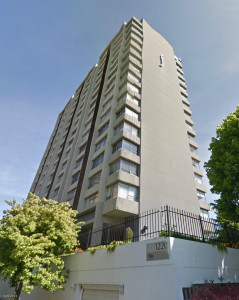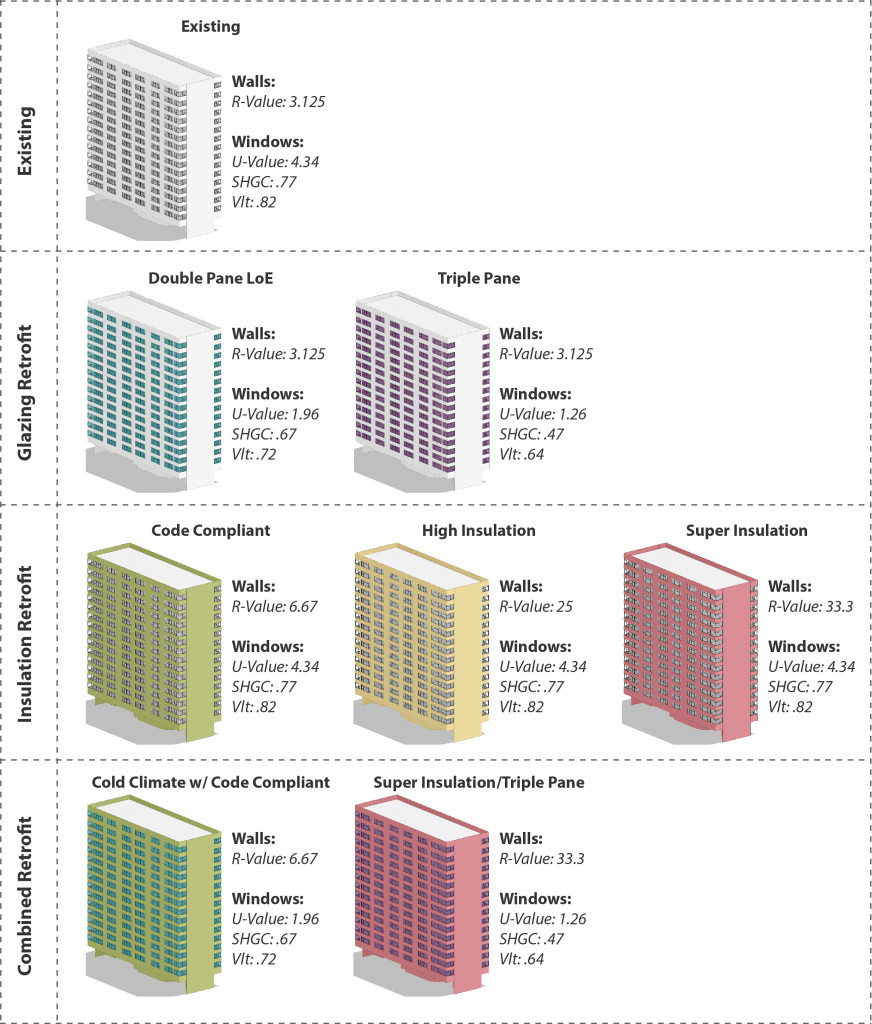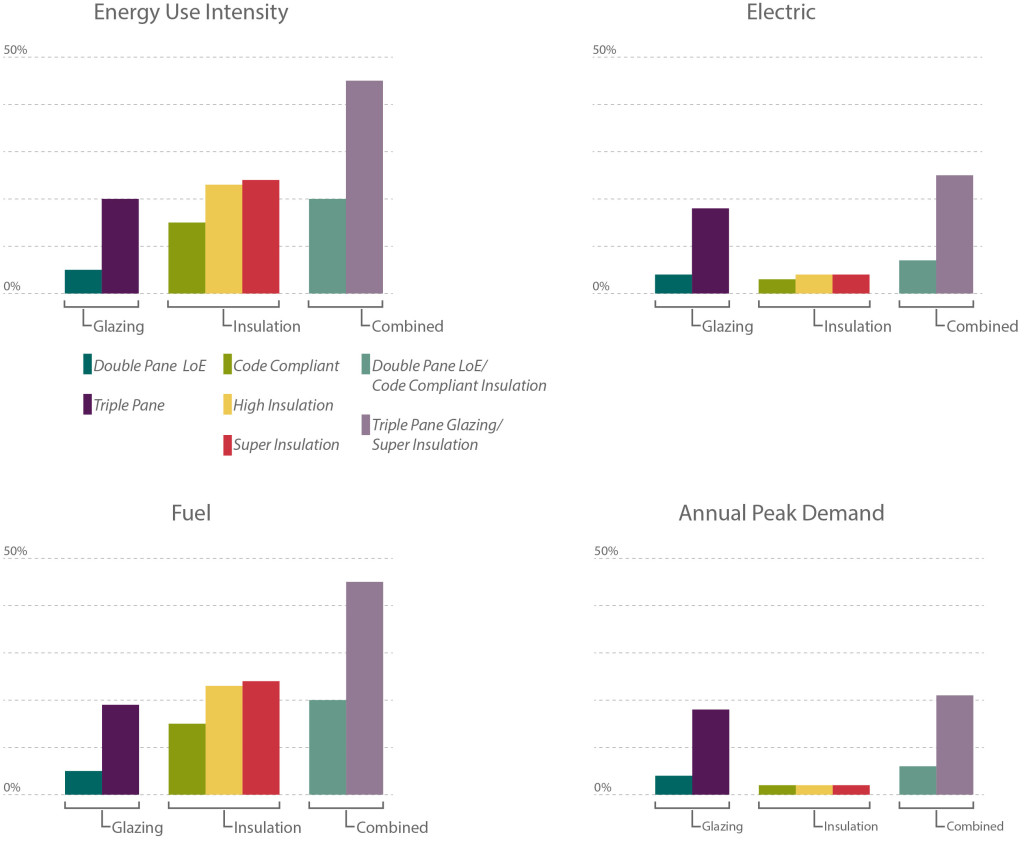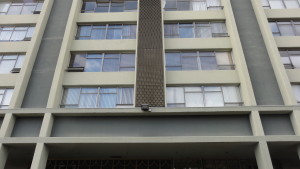As historic architects we find window replacement projects to be particularly challenging — removing original materials from a structure can fundamentally change the design aesthetic. Our built environment must evolve to support more sustainable living, but finding the best way to achieve this goal for historic structures, while minimizing any aesthetic impacts, is an ongoing challenge.
When looking to improve energy performance the first inclination is often to replace the component with the lowest thermal resistance – the windows. Single pane historic windows provide minimal thermal resistance and contribute to heat loss through the building envelope. But is window replacement really the best option for reducing the carbon footprint of a historic building – how does it compare to other strategies?
 PMA recently performed an energy analysis study to answer that question. The project was to provide quantitative data on the energy savings associated with window replacement versus insulating exterior walls. We choose to study a structure on the brink of historic status – a 1960’s multi-story residential structure with large character defining view windows. The structure is composed of concrete walls, beams, floors, and columns with single pane aluminum windows. The existing building has approximately 36% glazing and no insulation.
PMA recently performed an energy analysis study to answer that question. The project was to provide quantitative data on the energy savings associated with window replacement versus insulating exterior walls. We choose to study a structure on the brink of historic status – a 1960’s multi-story residential structure with large character defining view windows. The structure is composed of concrete walls, beams, floors, and columns with single pane aluminum windows. The existing building has approximately 36% glazing and no insulation.
The analysis we performed compared seven retrofit strategies ranging from minimal code compliance to super insulated walls and windows. Details on the specific constructions, r-values, and glazing properties are outlined below.
 A wide range of constructions were chosen in order to see the full range of possible results. Future studies may focus on more refined material choices and a narrower set of parameters. The analysis was run in Autodesk Green Building Studio which is an excellent tool to perform basic energy models. While GBS does not allow for complex simulations it can quickly and accurately compare a variety of different design alternatives.
A wide range of constructions were chosen in order to see the full range of possible results. Future studies may focus on more refined material choices and a narrower set of parameters. The analysis was run in Autodesk Green Building Studio which is an excellent tool to perform basic energy models. While GBS does not allow for complex simulations it can quickly and accurately compare a variety of different design alternatives.
We chose to look at four different indicators to compare the results:
• Energy Use Intensity (EUI) indicates how much energy is used per square foot per year and is a very common way of comparing how different buildings perform.
• The quantity of electricity used per year indicates how much energy is used on cooling loads, heating loads, interior loads, and lights.
• The quantity of fuel used per year indicates primarily energy used for heating.
• The annual peak demand indicates the maximum amount of energy used at any single time over the course of a year.
We assessed the data in terms of percentage improvement over the Existing scenario. The charts below provide a comparison of the seven different retrofits.

The Results
What is intriguing in the results is the large difference in performance within the glazing retrofits options between the Double Pane LoE Glazing and the Triple Pane Glazing. While the Double Pane Glazing provides a notable improvement to the building’s energy performance it is still surpassed by all of the other retrofits. Conversely the Triple Pane Glazing far out performs all of the insulation retrofit strategies. The range between the two glazing retrofits indicates that new windows have the potential to have a substantial impact on energy performance. Unfortunately triple pane glazing is typically cost prohibitive and the LoE coatings applied to achieve maximum efficiency are incongruent with historic buildings. As technologies change and improve it is possible that these obstacles will be overcome – potentially making window replacement for energy efficiency purposes a more viable option.
 With current technologies the results indicate that adding insulation to a building has the most cost effective impact on energy performance. Installing new insulation is typically less expensive than window replacement and the results of this study show that Code Compliant (R-~7) insulation can have a significant impact on overall energy usage, outperforming Double Pane window replacement. Interestingly, the results also indicate that a High Insulation (R-25) retrofit performs better than a Combined Retrofit with Code Compliant Insulation (R-~7) and Double Pane Glass.
With current technologies the results indicate that adding insulation to a building has the most cost effective impact on energy performance. Installing new insulation is typically less expensive than window replacement and the results of this study show that Code Compliant (R-~7) insulation can have a significant impact on overall energy usage, outperforming Double Pane window replacement. Interestingly, the results also indicate that a High Insulation (R-25) retrofit performs better than a Combined Retrofit with Code Compliant Insulation (R-~7) and Double Pane Glass.
The results clearly indicate that adding insulation is an excellent way to improve energy performance without impacting the exterior façade of a historic building. Like any retrofit, insulation poses its own challenges: can it be installed on the interior without affecting historic finishes? Will changes in the temperature of the wall cause deterioration?, etc. Conversely, there are instances where window replacement is the right choice (when the existing windows have reached the end of their lifespan) and in this instance choosing a double pane glazing option can improve energy performance. In most cases, if you are looking to improve the energy performance of your building – it is more effective to explore insulation retrofit options rather than window replacement.
Written by Halla Hoffer, Architect I
